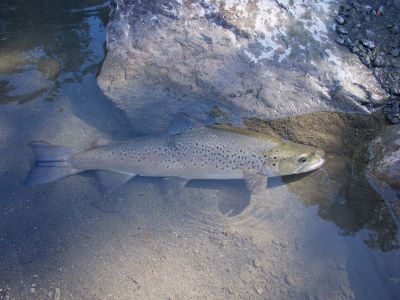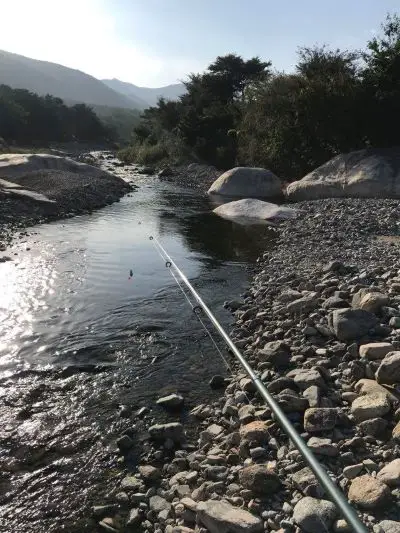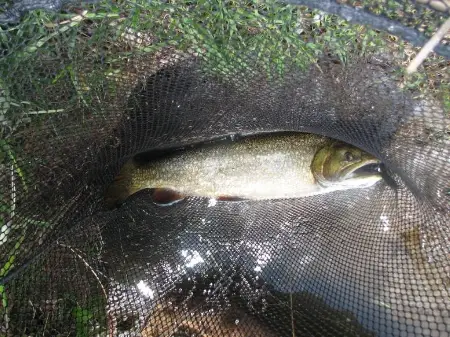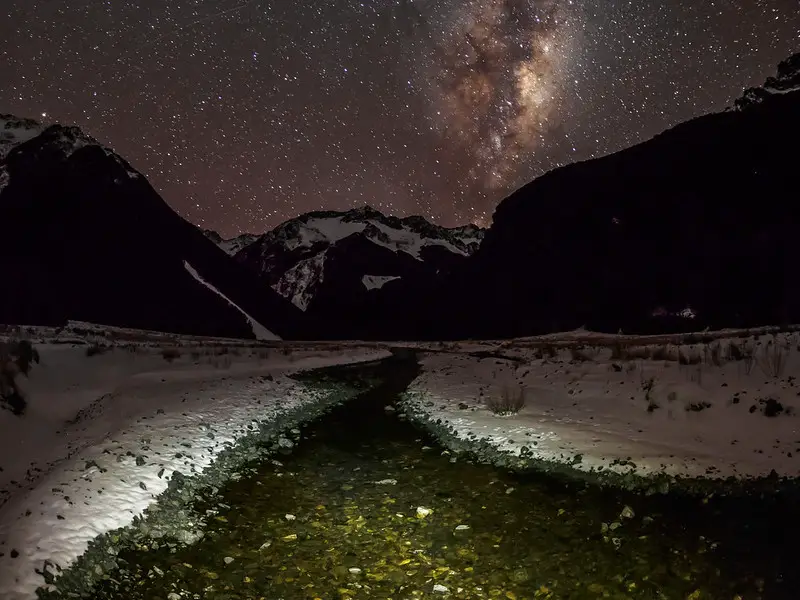To catch trout, we must know where they are. In this guide, I will give 7 hints to find new spots to target trout.
Trout fishing is becoming increasingly popular. The well known spots can be crowded, and the trout wary making them difficult to catch. While fishing beside other anglers can at times be enjoyable, sometimes it is nice to have a spot to your self.
One point I will like to make. Often the best trout fishing is on the river next to the famous one. The river which gets overlooked. The reason is simple, the famous rivers see to much fishing pressure, trout stock decline and any surviving fish become difficult to catch. While the Neighbouring rivers, see a lot fewer anglers which means the trout are under less pressure.
When I am reading lists of the best rivers, or flicking through the pages of a guide book. I always keep my eyes out for overlooked rivers which might just have a few lines describing them eg “X river holds a few trout, in the lower reaches, water can be cloudy due to snow melt”. Such a river will unlikely be crowded and you might even have the river to yourself.
The problem is, such little known spots are often difficult to find. Even more so for new anglers who do not have many hours of fishing beneath their belts.
- Spend as much time as possible out searching. Nothing is better than time on the water. I even scout streams during the off season.
- Join local fishing groups, forums and clubs. Can be either on or offline. Some share a lot of good info.
- Google Maps, topographical maps and aerial photos can provide a lot of clues.
- Books and local magazines are still worth considering. Even old copies.
- Build a relationship with the local shops, they provide a lot of good info. Just be careful what you share unless you want everyone to know. (Become a regular, know the staff, just buying one or two flies once a year is not going to get the best info)
- Use Google. Search the river name plus trout. Never know the info random blogs, small YouTube channels and old forum posts provide.
- Google Academic paper search can also be useful at times. Quite a few rivers have punished fish surveys.
- Consider using trout fishing mapping applications
To find trout, nothing beats time on the water
I have this point first, because it is the most important. The best way to find a new trout spot is to spend time out exploring. Visit as many likely looking streams, ponds and lakes as possible. Some surprisingly small streams can hold fish.
Also keep an eye on other cars and anglers. If there is a spot near a small stream where cars always seem to be parked. In trout fishing areas, there is a reasonable good chance that something interesting is happening in the stream below. Sure, it might just be a swimming hole, but often there are trout.
I have been able to find several good access tracks, just by keeping an eye on parked cars.

Join fishing groups, clubs and forums.
A wealth of information gets shared in such groups, and experienced anglers are often keen to help new comers to the sport.
There are excellent fishing groups both on and offline. Most online groups and forums are free to join and there is nearly always someone willing to share some valuable knowledge. Just remember to pay the favor back by helping others. Even today, when I am interested in a new river I search the forums and groups to try and find relevant discussions.
Even when travelling, I been giving invaluable advice just by asking on trout fishing forums and Facebook group. On one memorable occasion I even got invited out by a member to catch Surgeon on the Fraser River.
Local clubs are also worth considering, sure many are exclusive and require a large membership payment. But there are many more at a community level where anglers get together just to find companionship and share their skills with the next generation of anglers. Members of such groups, are often elderly with a lifetime of fishing knowledge they are willing to share.
Search Google Earth for new spots
The highly detailed satellite and aerial photographs on google earth is a great mapping resource to start your search with. Zoom in and just look for streams, rivers and ponds. When looking at streams, see how large they are. Do they have pools or deeper water which can sustain trout. Check the headwaters to, up in the hills.
Google Earth is slightly better than the browser based Google Maps, while the under laying maps are the same Earth has access to more advance features. One trick in Google Earth is to look at historical images. These shows earlier versions of the maps. By using the historical images you can see the river at different times of the year. Maybe it goes dry during the summer, or freeze solid in the winter. Maybe the river itself is very unstable and constantly changing course.
It is also possible to download and install various overlays. In my experience these can be a bit glitchy but can provide some useful additional. I sometimes use an overlay which places a transparent topographical map over the satellite images. There is a useful one just in Maine which displays a lot of fisheries data.
Google Earth is the biggest and most well known provider of online aerial maps. But it is not the only mapping service, and there are services which at times provide much higher resolution maps. It really is location dependent. The best resolution is normally from extremely localize aerial photos.
The next biggest provider is Bing Maps. It is okay, but I prefer Google Earth, because most of the time it provides better resolution.
Earth Explorer by the USGS also provides a useful product. The resolution of the map is quite similar to Google Earth (maybe a touch more crisp) and it provides easy access to topographical maps.
Zoom.Earth is another good alternative which I do not use often enough. It’s maps are high resolution and uses different aerial footage than google.
Even with all the fancy aerial and satellite maps, I still use topographical maps, I find them useful to get a better idea on how steep the terrain is, plus they generally have better details of tracks in remote areas. Finding a great new spot is one thing, accessing it is another.

Books and Magazines are still
With information so readily available on the internet. Many people seem to forget books exist, but they remain such an excellent source of information.
There are guide books out there with detailed summaries of what to expect in many rivers. There are also many books written by fishing enthusiasts, sure many are very secretive regarding exact names but they usually drop enough clues to get a fair idea where they are fishing.
Fishing magazines are also well worth reading, and not just new ones. Old magazines from 10, 20 years still provide so much useful information. Sure technology has changed, but the trout have not. I sometimes even read vintage magazines and newspaper looking for clues. The fishing was much better back then, but it is still interesting learning about the local rivers and catches from a much earlier time.
Local shops are a great source of trout fishing knowledge
Your local fly fishing or angling shop can provide excellent knowledge on where to fish. I often hear the advice, go in and buy a few flies or some tippet and ask where to fish. Sure, that will give you a few known spots. But it is well worth building a relationship with such stores.
Become a regular, support them. The shop owner and staff will start to recognize you and it is just human nature to share more information with people they know.
We all know that trout fishermen can be big gossips, and that is where shop staff gain their massive knowledge. Exact spot names might be rare, but the general insights are invaluable.

Google Search
Maybe this should of been higher on the list. Go to google, type in a river or pond name followed by the word trout and see what it brings up.
There are so many blogs, magazines, forums and general communities online involving trout fishing, and the simple act of just searching for a place name and trout often brings up a lot of valuable information.
Google Academic paper search
If you want to find rare species of fish. Then the academic papers are often the best source of information.
Trout anglers are a secretive bunch, and many choice to keep rare species hidden to reduce the angling pressure.
Scientist on the other hand publish their research and usually give exact locations. Their surveys have to be repeatable after all. By reading academic papers I been able to find the location of introduced golden trout and other locally rare species.
Several times, while researching areas where all other avenues have turned up empty. I was only able to find exact locations by searching for scientific papers.
Trout fishing Applications
There is now an increasing number of fishing applications. Some of the more popular ones include Toutroute and OnX, which provide maps, car parking and access information for many trout fishing locations. Most of them charge a fee for their more premium features.
The accuracy of the applications are a bit hit and miss, and some errors do slip through but overall they seem to be a user friendly way to locate many of the more well known rivers and streams which hold trout.
If you are short on time, or just hate researching then these apps are a good way to point you in the right direction.

